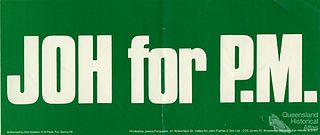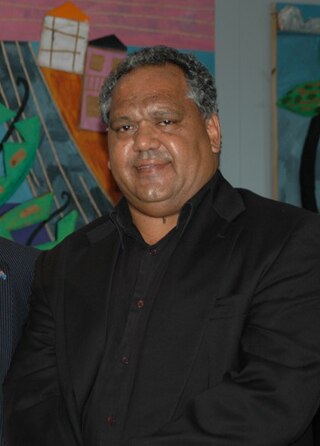Related Research Articles

Sir Johannes Bjelke-Petersen was an Australian politician. He was the longest-serving premier of Queensland,holding office from 1968 to 1987 as state leader of the National Party.

The Cape York Peninsula is a peninsula located in Far North Queensland,Australia. It is the largest wilderness in northern Australia. The land is mostly flat and about half of the area is used for grazing cattle. The relatively undisturbed eucalyptus-wooded savannahs,tropical rainforests and other types of habitat are now recognised and preserved for their global environmental significance. Although much of the peninsula remains pristine,with a diverse repertoire of endemic flora and fauna,some of its wildlife may be threatened by industry and overgrazing as well as introduced species and weeds.

The Joh for Canberra campaign,initially known as the Joh for PM campaign,was an attempt by Queensland National Party premier Sir Joh Bjelke-Petersen to become Prime Minister of Australia. The campaign was announced in January 1987 and drew substantial support from Queensland businessmen and some conservative politicians. The campaign caused a split in the federal Coalition. It did not attract widespread support and collapsed in June 1987. The Australian Labor Party,led by Bob Hawke,went on to win the 1987 federal election with an increased majority,gaining its highest-ever number of seats. Bjelke-Petersen came under increasing scrutiny as the Fitzgerald Inquiry gained traction,and was forced out of politics altogether in December 1987.
Robert Edward Borbidge is a former Australian politician who served as the 35th Premier of Queensland from 1996 to 1998. He was the leader of the Queensland branch of the National Party,and was the last member of that party to serve as premier. His term as premier was contemporaneous with the rise of the One Nation Party of Pauline Hanson,which would see him lose office within two years.

Michael John Ahern was an Australian National Party politician who was Premier of Queensland from December 1987 to September 1989. After a long career in the government of Sir Joh Bjelke-Petersen,Ahern became his successor amid the controversy caused by the Fitzgerald Inquiry into official corruption. Ahern's consensus style and political moderation contrasted strongly with Bjelke-Petersen's leadership,but he could not escape the division and strife caused by his predecessor's downfall.

Sir Walter "Wally" Benjamin Campbell,was an Australian judge,administrator and governor. He was the Chief Justice of the Supreme Court of Queensland,Chancellor of the University of Queensland and the 21st Governor of Queensland from 1985 to 1992.

Noel Pearson is an Australian lawyer and founder of the Cape York Partnership,an organisation promoting the economic and social development of Cape York. He is also the Founder of Good to Great Schools Australia an organisation dedicated to lifting education outcomes for all Australian students.

Marcia Lynne Langton is an Aboriginal Australian writer and academic. As of 2022 she is the Redmond Barry Distinguished Professor at the Melbourne School of Population and Global Health,University of Melbourne. Langton is known for her activism in the Indigenous rights arena.

The Northern Peninsula Area Region is a local government area in Far North Queensland,Australia,covering areas on the northwestern coast of Cape York Peninsula. It was created in March 2008 out of three Aboriginal Shires and two autonomous Island Councils during a period of statewide local government reform.

The Cape Bedford Mission was the first Christian mission on the Cape York Peninsula of Queensland,Australia. It is the oldest surviving mission in northern Queensland. It is at South Cape Bedford within the present-day locality of Hope Vale.
Terrence Anthony White is an Australian pharmacist,businessman,and former politician. White achieved notoriety when,as Queensland state leader of the Liberal Party he terminated the longstanding coalition agreement between the Liberal Party and the National Party of Joh Bjelke-Petersen. In the ensuing election,the Liberals were badly defeated,and White was replaced as party leader. After leaving politics,he established TerryWhite Chemmart,a nationwide pharmacy franchise,and became a widely respected businessman.
The Ginger group,in Queensland politics was a group of Liberal Party MLAs during the 1960s,1970s and 1980s,who despite nominally being a part of the government,were opposed to some of the policies of their senior coalition partner,the National Party. Initially a small informal grouping within the Liberal Party,the group came to wield greater and greater power within the Liberal partyroom,culminating in Terry White's successful leadership challenge in 1983,and the party's subsequent defeat and loss of influence at the 1983 election.
John Angus Mackenzie Innes was a Queensland politician and leader of the state Liberal Party.

Michael John "Mick" Miller was a notable Aboriginal Australian activist,politician,and statesman who campaigned for most of his life seeking greater social justice,land rights,and improved life opportunities for Aboriginal Australians in North Queensland and the rest of Australia.
Terry O'Gorman is a lawyer in Queensland,Australia and leading civil libertarian. In 1979,O'Gorman was elected President of the Queensland Council for Civil Liberties ('QCCL') and served as president until 1985. He again held presidency from 1990 to 1994. He is currently the Vice President of the QCCL.
Guelfi Paul Scassola was an Australian politician. He was a Liberal Party member of the Legislative Assembly of Queensland from 1977 until 1983,representing the electorate of Mount Gravatt.
Charles Robert Porter was a British born Australian politician,author,playwright and broadcaster. He was the Liberal member for the Electoral District of Toowong in the Legislative Assembly of the Australian state of Queensland from 1966,and the Minister for Aboriginal and Island Affairs from 1977. Before his parliamentary career,Porter engaged in a career in radio and broadcasting,along with other creative pursuits.

The National Party of Australia –Queensland (NPA-Q),commonly known as the Queensland Nationals,National Party of Queensland or simply the Nationals,was the Queensland branch of the National Party of Australia (NPA) until 2008. Prior to 1974,it was known as the Country Party. The party was disestablished in 2008,when it merged with the Queensland division of the Liberal Party of Australia to form the Liberal National Party of Queensland (LNP).

The Queensland Liberal Party,officially known as the Liberal Party of Australia,was the Queensland division of the Liberal Party of Australia until 2008.

The Cape York International Spaceport was an abandoned 20th century proposal to build the world's first commercial spaceport in Australia's Cape York Peninsula. The plan was announced in 1986 by then-Queensland Premier Joh Bjelke-Petersen,who confiscated Indigenous Australian land in Far North Queensland for the spaceport's construction. The location was chosen due to its proximity to the Equator,which would allow easier and cheaper space launches. Following legal challenges from local indigenous groups whose land had been taken for the project,increased federal environmental standards and a lack of financial support from the private sector,the project was abandoned in 1992.
References
- 1 2 3 "Former Members". Parliament of Queensland. 2015. Retrieved 1 February 2015.
- ↑ Wear, Rae (2002). Johannes Bjelke-Petersen: The Lord's Premier. University of Queensland Press. p. 142.
- ↑ Murphy, Damien (26 August 2003). "Turncoat turned into a footnote". The Sydney Morning Herald.
- ↑ Rothwell, Nicolas (3 September 2008), "Indigenous insiders chart an end to victimhood", The Australian
- 1 2 3 "Radio National: Background Briefing: Noel Pearson". Australian Broadcasting Corporation. 29 October 2000. Retrieved 13 June 2012.
- ↑ Sutton, Peter (9 August 2008), "Twilight of old radicals", The Australian
- ↑ Jopson, Debra (26 January 1995), "Mansell working for a new national day", The Australian
- ↑ Jopson, Debra (15 April 1996), "Integration push for Aborigines", The Australian
- ↑ "Australian Story: The Mission". Australian Broadcasting Corporation. Retrieved 13 June 2012.